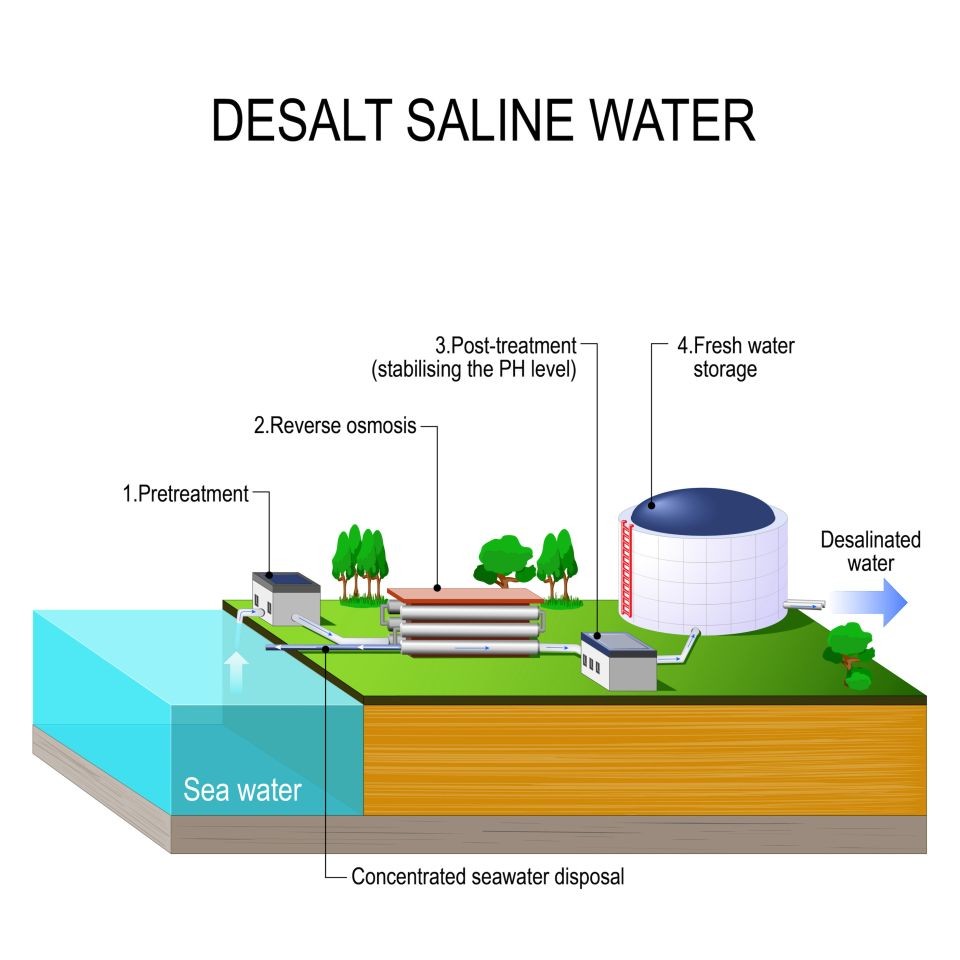Will Egypt resort to desalinating seawater to avoid the negative effects of the Ethiopian Renaissance Dam?
What is the ability of desalinated water to compensate for the potential shortfall that will result because of the Ethiopian Renaissance Dam? Ahmad Abdul-Rahman investigates.
Egyptian President Abdel Fattah El-Sisi, on the issue of the Ethiopian Renaissance Dam, mentions water reuse and seawater desalination projects with every talk he gives, insisting that Egypt will be ready for the construction of the Ethiopian Renaissance Dam on the Nile River. The river supplies Egypt with more than 90 per cent of its water.
According to a speech by the Egyptian president in early June, the amount of water received from the Nile has been constant since Egypt's population was 3 million. The population has now increased to more than 100 million people.
With the complexity of negotiations with Ethiopia regarding the dam and the population increase, which records 2.5 million births annually, Egypt has intensified sewage treatment and seawater desalination projects, implementing the water resources development strategy, which was announced by the Ministry of Irrigation in December 2016. This strategy aims to achieve water security through four main axes: development of water resources, whether traditional or non-traditional; rationalisation of water uses and maximising the return from consumed water; improving water quality by confronting pollution; and creating the appropriate environment for the integrated management of water resources.
Water treatment
According to statistics from the Ministry of Housing and Urban Utilities, between 2014 and 2021 Egypt implemented 180 more water treatment plants for reuse, an increase of about 60 per cent over previous figures. Before 2014, the number of desalination plants reached about 300 treatment plants. The capacity of the sewage treatment plants is currently 16.2 million cubic metres per day, according to local press reports. In addition, 211 treatment plants are being implemented, with a capacity of 6 million cubic metres per day.
These plants follow advanced bilateral treatment technology or triple treatment, in accordance with international health standards. The Egyptian president, El-Sisi said in his speech: "Egypt is the first or second country in the world to benefit from water treatment and desalination for the benefit of its people."
Adviser to the former Egyptian Minister of Irrigation, Diaa Al-Qusi, believes that water treatment projects cannot be linked to the Renaissance dam project. Al-Qusi says that these projects do not add much to the total water resources. Rather they improve the management of Egypt's share of the Nile water, which amounts to 55.5 billion cubic metres annually. He affirms that Egypt reserves the right not to derogate from this legitimate and legal quota under the Nile Basin Countries Agreement signed in 1929. He added that sewage treatment plants produce about 15 million cubic metres per day, which means more than 5 billion cubic metres annually, or about 10 per cent of Egypt's Nile share, was wasted in the Mediterranean. This is set to change.
Egypt has also intensified its move to seawater desalination, as the strategic plan for desalination until 2050 includes access to a capacity of 6.4 million cubic metres per day, instead of 1.2 million cubic metres currently, at a cost of about EGP 134 billion, according to the Minister of Housing Assem El-Gazzar.
High cost
Egypt's productivity of desalinated water was not more than 80,000 cubic metres per day once, but after the projects implemented in recent years, productivity reached 850,000 metres per day at the end of last year. This is set to increase according to Al-Qusi. Desalinated water amounts to about 12 Egyptian pounds (0.64 USD) per cubic metre.
Local press reports quoted Ministry of Housing sources as saying that the cost of one cubic metre of desalinated water ranges between EGP 13 and EGP 15 (USD 0.69 and USD 0.80). And the water sourced from the Nile River costs EGP 2.5 to EGP 4.5 pounds per cubic metre (USD 0.13 and USD 0.24), and groundwater ranges from EGP 4 (0.21 dollars) to EGP 6 ( USD 0.32). Egyptian citizens will pay a subsidised price.
Water poverty
The Egyptian Minister of Irrigation, Mohamed Abdel-Aty, had referred in previous statements to the high cost of desalinating sea water, pointing out that the volume of desalination investments reached EGP 15,000 annually (USD 800) for every cubic metre of water in addition to the operation. Abdel-Aty stressed that it is not possible to use desalinated water in agriculture because the yield of agricultural crops will be less than the cost of water, and that the optimal economic use of desalinated seawater is through its introduction into domestic and tourist consumption.
Egypt's water need annually amounts to about 114 billion cubic metres, and it imports 30 billion cubic metres annually of what is called virtual water, which are agricultural and animal food products, which would have consumed that amount of water if it was produced locally. According to the Ministry of Irrigation, the total water resources of Egypt are about 60 billion cubic meters, which includes Egypt's share of the Nile water, which amounts to 55.5 billion cubic meters, 85 per cent of which comes from the Ethiopian plateau, and about 2.1 billion cubic meters from deep groundwater. This is in addition to 3.1 billion cubic metres of rain and torrential water, and the desalination of saline water, amounting to 350 million cubic metres annually (according to 2016 estimates). This means there is a water deficit estimated at more than 20 billion cubic metres. This increases every year in line with the population increase.
According to previous statements by the Egyptian Minister of Irrigation, Egypt is one of the most water-scarce countries in the world, prompting the government to develop a plan to manage water resources until 2037, with investments exceeding USD 50 billion. These investments are expected to increase to USD 100 billion by 2050. It also aims to improve water quality, develop new water resources, and rationalise the use of available resources.


Comments